Prices in AUD. Shipping worldwide. Flat rate $8 postage per order within Australia. International by weight calculated at checkout. Read full terms.
-
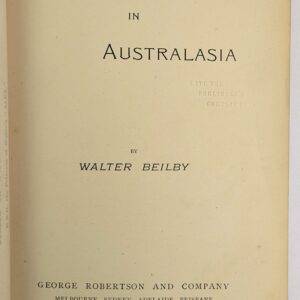
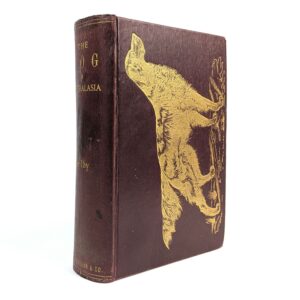
The Dog in Australasia
AU$1,000.00 Read MoreAdd to cartWalter Beilby
Melbourne: George Robertson and Company, 1897.The first Australian dog breeder’s manual. FERGUSON 6885.
-
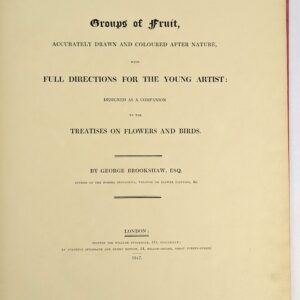
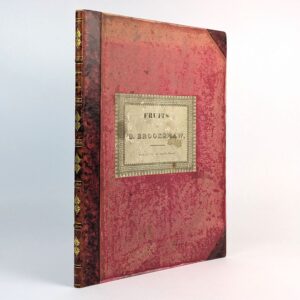
Groups of Fruit, Accurately Drawn and Coloured After Nature, with Full Directions for the Young Artist: Designed as a Companion to the Treatises on Flowers and Birds.
AU$2,000.00 Read MoreAdd to cartGeorge Brookshaw
London: For William Stockdale by Augustus Applegath and Henry Mitton, 1817.The rare first edition of the second part of the three part treatise on natural history painting by the English artist and author of Pomono Britannica, George Brookshaw (c.1751-1823). Each plate: Apples, Apricots, Cherries, Currants, Pears, Plums; is presented in two states, un-coloured and with hand-colouring, and each is accompanied by 1 or 2 pages of instructive text. This copy complete, but with the plates bound in alphabetical order, rather than the order of the instructive text.
-
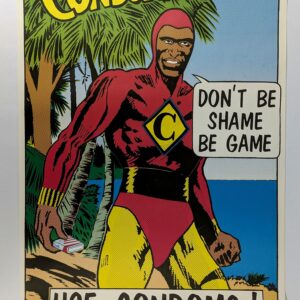
Condoman Says: Don’t Be Shame Be Game. Use Condoms!
AU$300.00 Read MoreAdd to cartDepartment of Health, Housing and Community Services, Aboriginal Health Workers of Australia (Queensland)
Queensland: Department of Health, Housing and Community Services, Aboriginal Health Workers of Australia, No date.Early/mid 1990s issue of the iconic Aboriginal HIV/AIDS awareness campaign poster (the earliest issues captioned USE FRENCHIES! instead of condoms). Originally conceived in 1987 by Aunty Gracelyn Smallwood and a small team of Aboriginal health workers in Townsville, Queensland, Condoman became one of the most successful Australian sexual health campaigns.
-
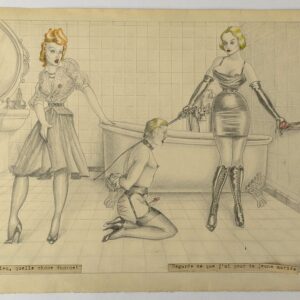
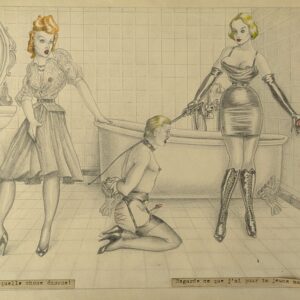
Mon Dieu, Quelle Chose Enorme!
AU$1,200.00 Read MoreAdd to cartBernard Montorgueil
: Bernard Montorgueil, No date.Original femdom drawing by mysterious fetish artist Bernard Montorgueil. Montorgueil produced a number of French erotic works in the 1920s and 1930s which became very popular with the BDSM community through the latter half of the 20th century with a number of reprints of Montorgueil’s manuscripts published. This is an original drawing in pencil with colour highlights showing two women dominating a sissified male in a bathroom, with an additional glory hole tease. With mounted typescript captions: Mon Dieu, Quelle Chose Enorme! Regarde ce que j’ai pour ta jeune mariee / [My God, What a Huge Thing! Look what I have for your bride!] and signed by the artist in the bottom right corner.
-
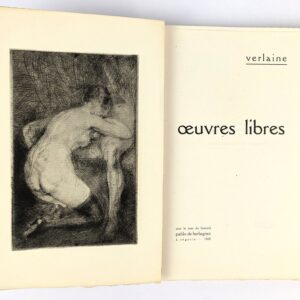
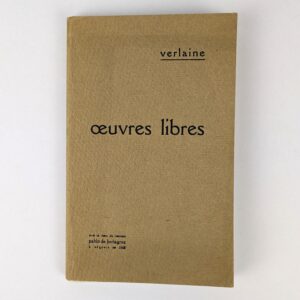
Oeuvres Libres
AU$650.00 Read MoreAdd to cartPaul Verlaine
Segovie: Pablo de Herlagnez, 1868 [c. 1930].Clandestine 20th century anthology of Verlaine’s Amies, Femmes, Hombres (except the last 4 quatrains of Balanide I), and Sonnet du trou du cul [Sonnet to an Asshole] by Verlaine and Arthur Rimbaud. With erotic chapter initials and accompanied by 6 erotic etchings by an anonymous artist. Edition of 400 copies, though often found without the suite of plates, here the plates are on thick Holland laid paper and not vellum as described in PIA 1440, DUTEL 2092.
-
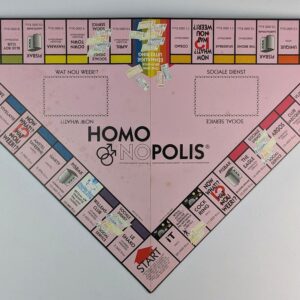
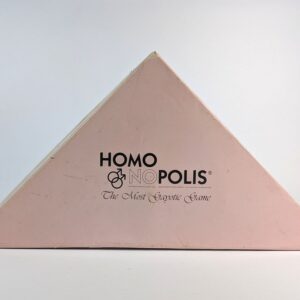
Homonopolis: The Most Gayotic Game
AU$800.00 Read MoreAdd to cartStef de Knegt; Alexander M. Kroner
Amsterdam: Studio Fab / Identity Games International, 1994.Dutch Gay Monopoloy adaptation. Differing form the American Gay Monopoly published in 1983 (and much better rated according to Board Game Geek). In Homonopolis players travel around a triangular board cruising the gay bars and venues of Amsterdam. Instead of building houses and hotels players purchase barkeepers and backrooms. Jail is replaced with an SM Cellar where instead of Just Visiting you are Just Peeping Through the Glory Holes. Everything you might expect . The rulebook and the board are bilingual in Dutch and English. At 138 pages the book goes well beyond explaining the game, delving into the gay history of the Netherlands as well as an extensive directory of services, illustrated throughout by photographs of gay Amsterdam in the 1990s and with advertisements for a colourful assortment of local gay businesses that sponsored the production of the game.
-
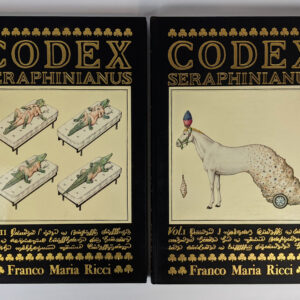

Codex Seraphinianus (2 Volumes)
AU$4,000.00 Read MoreAdd to cartLuigi Serafini
Milano: Franco Maria Ricci, 1981.The first edition of the ever mysterious Codex Seraphinianus by Italian artist Luigi Serafini (1949-). Possibly an illustrated encyclopaedia of an alternate universe, Serafini has alluded that it is perhaps all just the thoughts of a cat passed through his hand. The Codex is written in an imaginary language and illustrated phantasmagorically throughout. This being the true first edition published in 2 volumes by Italian art publisher Franco Maria Ricci. This copy numbered 2295 and signed by Serafini to the colophon of volume 2, with the original trilingual letter from the editor laid in, together with a FMR catalogue, several photocopied Italian newspaper clippings related to the Codex, as well as the deluxe edition of the only published volume of literary criticism in English on the Codex Seraphinianus, Confronting Serafini by Jordan Hunter (2017), all housed in the original shipping cartons. Confronting Serafini is a 36 page book hand-bound with treated pages from the 2013 Rizzoli edition of the Codex, signed and numbered in a limited edition of 10, of which this is number 10.
-
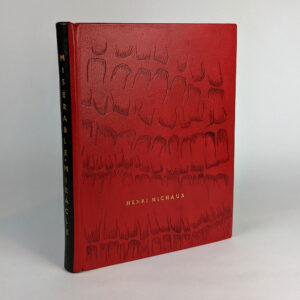
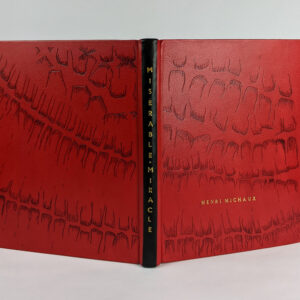
Miserable Miracle (La Mescaline)
AU$1,000.00 Read MoreAdd to cartHenri Michaux
Monaco: Editions du Rocher, 1956.The accounts, observations, and literary manifestations of Henri Michaux (1899-1984), Belgian born French poet and artist, while on mescaline. Associated with the Tachiste movement in the 1940s and 1950s, Michaux was one of the original 20th century artists to take drugs and make art. This copy has been finely bound in full leather by Queensland bookbinder Karen McGuire, with a design based on one of Michaux’s drawings. One of the standard edition of 1,500 numbered copies, of which this is 1,256.
-
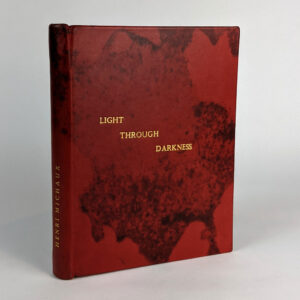
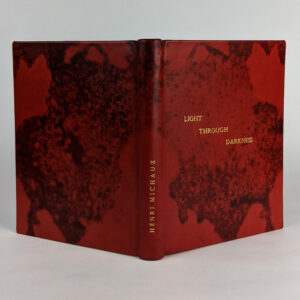
Light Through Darkness
AU$1,000.00 Read MoreAdd to cartHenri Michaux
New York: The Orion Press, 1963.The accounts, observations, and literary manifestations of Henri Michaux (1899-1984), Belgian born French poet and artist, on mescaline, psilocybin, and marijuana. Originally published in French in 1961, then translated into English by Haakon Chevalier and first published in America in 1963. Associated with the Tachiste movement in the 1940s and 1950s, Michaux was one of the original 20th century artists to take drugs and make art. This copy in a fine signed full leather binding by Queensland bookbinder Karen McGuire based on the original jacket design.
-
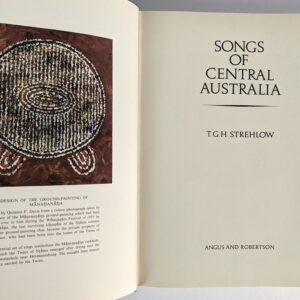
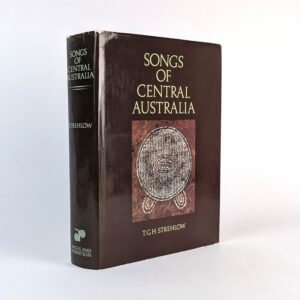
Songs of Central Australia
AU$9,000.00 Read MoreAdd to cartT. G. H. Strehlow
Sydney: Angus & Robertson, 1971.“The first complete account of the poetic heritage of the aboriginal people of Central Australia; an analysis of aboriginal songs as fully-developed oral literature, and their evaluation as authoritative documents of aboriginal religion” (from original prospectus). One of the scarcest and most sought after works on Aboriginal life. “You could describe it as the Torah of Central Australia.” (Barry Hill)
-
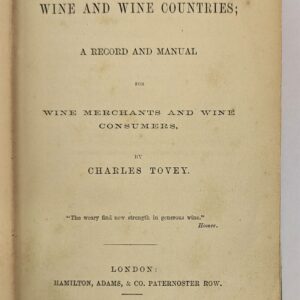
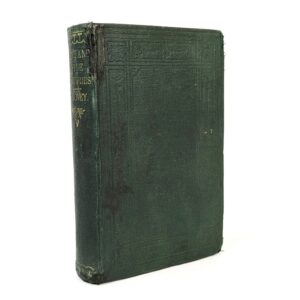
Wine and Wine Countries; A Record and Manual for Wine Merchants and Wine Consumers
AU$600.00 Read MoreAdd to cartCharles Tovey
London: Hamilton, Adams, & Co., 1862.On wine and related beverages around the world, including a section on the burgeoning Australian winemaking trade. This copy with the bookplate of Australian winemaker Max Lake.
-
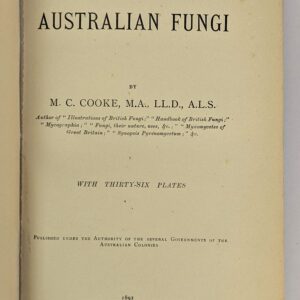
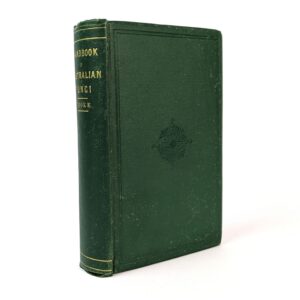
Handbook of Australian Fungi
AU$1,500.00 Read MoreAdd to cartM. C. Cooke
London: Williams and Norgate for the Departments of Agriculture in Melbourne, Brisbane, Sydney, Adelaide, Hobarton, 1892.The first monograph on Australian fungi by English botanist and mycologist Mordecai Cubitt Cooke (1825-1914). Containing descriptions of 2079 species of macrofungi, microfungi, and slime moulds (or myxomycetes), of which 377 figures are illustrated across 36 plates. The samples which the handbook are based on were supplied by Ferdinand von Muller, Flora Martin, F. M. Bailey, Sven Berggren, and others, and shipped to Cooke in England. This distance limited the accuracy of the work, nevertheless, as the first volume devoted to the subject its historical import cannot be understated and remains a key work in any Australian mushroom collection.
-
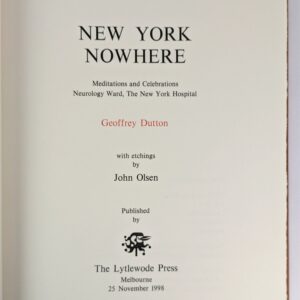
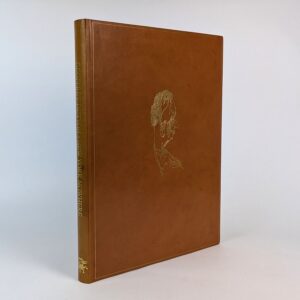
New York Nowhere: Meditations and Celebrations, Neurology Ward, The New York Hospital
AU$6,000.00 Read MoreAdd to cartGeoffrey Dutton; John Olsen
Melbourne: The Lytlewode Press, 1998.One of 30 deluxe copies from the total edition of 175 numbered copies signed by John Olsen and Robert Littlewood containing ten original signed etchings by John Olsen. The deluxe issue bound in brown kangaroo leather by Friedhelm Pohlmann also contains a tipped in sheet of original manuscript by the poet, ten original photographs of the artist and the poet signed by the publisher, five pieces of typescript correspondence hand signed by the publisher, 2 additional unsigned Olsen etchings, and an envelope containing a CD of Dutton reciting his poem. The recording of the CD made only weeks before Dutton’s death. New York Nowhere was Dutton’s last literary work, reflecting on the poet’s stroke and recovery in a New York hospital. Also included is the original prospectus and The Australian Magazine Dec 12-13, 1998 with the cover story on this work.
-
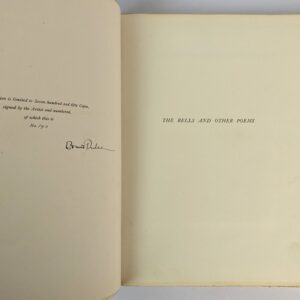

The Bells and other Poems
AU$3,000.00 Read MoreAdd to cartEdgar Allan Poe; Edmund Dulac
London: Hodder & Stoughton, 1912.The deluxe edition of the poems of Edgar Allan Poe featuring The Bells, The Raven, and others. Illustrated with 28 tipped in colour plates and additional vignettes by Edmund Dulac and published in a numbered edition of 750 copies signed by Dulac.
-
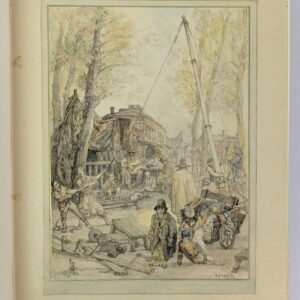
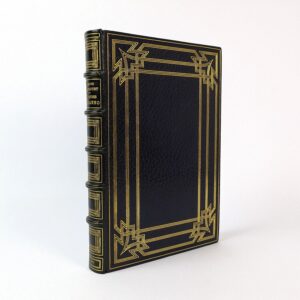
Les Freres Zemganno
AU$3,000.00 Read MoreAdd to cartEdmond de Goncourt; Auguste Brouet
Paris: Edite par F. Gregoire, 1921.Goncourt’s Naturalist exploration of the evolution of French literature through the acrobatic artistry of two circus brothers, also echoing and exploring his own love and loss of his inseparable brother (and literary partner) who passed some years prior. Originally published in 1879, here for the first time with numerous illustrations by Auguste Brouet. The illustrations include 15 full page etchings, a half-page etching on the half-title, and a vignette on the title, all signed in the plate, together with a further 51 illustrations in the text. This copy extra illustrated with 4 original signed drawings by Brouet mounted at the beginning, and finely bound in a signed full leather binding by Ganape, RD, dated 1925, and with the bookplates of Yvan Lamberty and B. Le Dosseur.
-

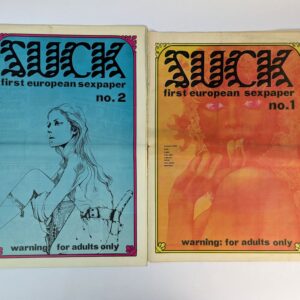
Suck: First European Sexpaper
AU$2,000.00 Read MoreAdd to cartWilliam Levy; Heathcote Williams; Germaine Greer; Susan Jansen; Lynne Tillman; Jim Haynes; Willem de Ridder
London and Amsterdam: Joy Publications, 1969-74.A complete set of Suck, touted as the first European sex newspaper tasked with creating “a new pornography which would demystify male and female bodies”. Launched in London in 1969 before moving to Amsterdam to avoid England’s anti-obscenity laws. Heathcote Williams in his Suck manifesto declares “SUCK is Group Sex, Police Sex, Animal Sex, Teeny Sex, One Armed Bandit Sex, Geriatric Sex and Cosmic Sex”, highlighting the nothing is off-limits approach of the editorial board. Though Suck was no mere porno rag, as Australian feminist writer and Suck co-founder Germaine Greer told the academic journal Women’s Studies International Forum, Suck was “a new kind of erotic art, away from the tits ‘n’ ass and the peep-show syndrome.” Greer’s involvement helped push a wave of radical feminist pornography, though she fell out with her co-editors and resigned after they published a photograph of her naked with her legs over her head, not because of the nudity, but the context of its publishing, which is outlined in Greer’s resignation letter printed in the final issue. Greer’s involvement was not the only tip to a radical cause with noted contributors including William S. Burroughs, Valerie Solanas, Michael McClure, W. H. Auden, Guillaume Apollinaire, Maurice Girodias, and many others. Primary editors were William Levy, Heatcote Williams, Germaine Greer, Susan Jansen, Lynne Tillman, and Jim Haynes, with art direction by Willem de Ridder.
-
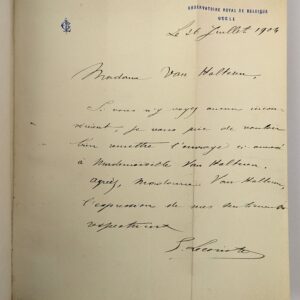
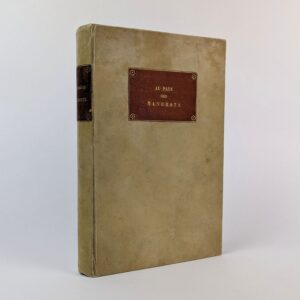
Expedition Antarctique Belge. Au Pays des Manchots: Recit du Voyage de la Belgica
AU$1,800.00 Read MoreAdd to cartGeorges Lecointe
Bruxelles: Societe Belge de Libraire, 1904.Account of the captain of the RV Belgica, the second in command of the first Belgian Antarctic Expedition of 1897-1899. Considered the first expedition of the Heroic Age of Antarctic Exploration, it was the first expedition to spend the entire winter in the region. Trapped in the ice for a year, they were ill prepared, the polar night driving a number of the crew mad and with scurvy setting in they were forced to subsist on penguin (largely considered inedible). Despite the challenges much scientific data was gathered including around 700 rock samples, for the first time meteorological observations were recorded for a full Antarctic year, and 188 new animal species were discovered. This superlative copy bound in full vellum with leather labels and decorative endpapers, and with a bound in manuscript letter dated 26 July 1904 from Lecointe to Madame Van Halteren requesting her to give the book to her daughter, Miss Van Halteren, signed by Lecointe, also with his monogram stamp and the stamp of the Royal Observatory of Belgium.
-
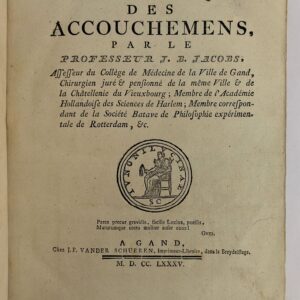

Ecole Pratique des Accouchemens.
AU$1,000.00 Read MoreAdd to cartJ. B. Jacobs
A Gand: Chez J. F. Vander Scheuren, 1785.First French translation of the important Dutch obstetrics manual by Jan Bernard Jacobs (1734-1790). At the time of its appearance, it was one of the most complete treatises on the art of childbirth and remained a standard work into the middle of the nineteenth century being described as a pearl of scientific production from the last years before the French Revolution.
-

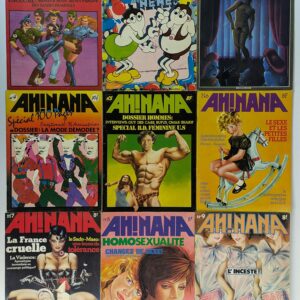
Ah! Nana (Complete Set, 9 Issues)
AU$1,200.00 Read MoreAdd to cartJanic Guillerez; Marjorie Alessandrini; Anne Delobel; et al.
Paris: Les Humanoides Associes, 1976-1978.Complete set of the French women’s comic magazine Ah ! Nana which evolved out of and was published by the comic book publishing house of Moebius (Jean Giraud), Jean-Pierre Dionnet, Philippe Druillet, and Bernard Farkas, Les Humanoides Associes. During a staff lunch of their magazine Metal Hurlant (the original of the English adaptation Heavy Metal), Jean-Pierre suggested to the women present (including his wife Janic Guillerez who became chief editor of Ah! Nana) to create a women’s magazine and feminist newspaper. Ah!Nana ran for nine issues, each with its own theme, coming to a short end following the magazine being banned to minors after the publication of the eighth issue devoted to homosexuality. This led the editorial team to go all in on the ninth and final issue, devoting it to incest, leading to the French censorship Commission banning the publication, labelling it pornographic.
-
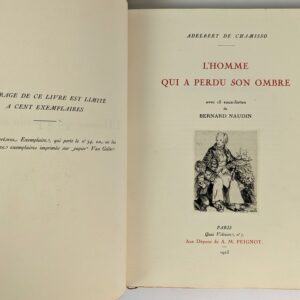
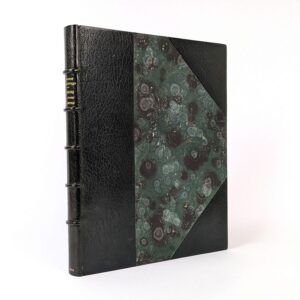
L’Homme qui a perdu son Ombre
AU$1,200.00 Read MoreAdd to cartAdelbert de Chamisso; Bernard Naudin
Paris: A. M. Peignot, 1913.French translation from the original German of Peter Schlemihls wundersame Geschichte (English: The Man with No Shadow) by the exiled French aristocrat, poet, and botanist, Adelbert von Chamisso (1781-1838). The story follows Peter Schlemihl who sells his shadow to the Devil for infinite money. The first edition with 15 engravings by French artist Bernard Naudin (1876-1946) limited to 100 numbered copies, this being one of 75 copies on Van Gelder paper, in a signed fine binding by Bernasconi with the original wrappers bound in. Peter Schlemihl was Naudin’s first major project after giving up painting to devote himself exclusively to printmaking.
